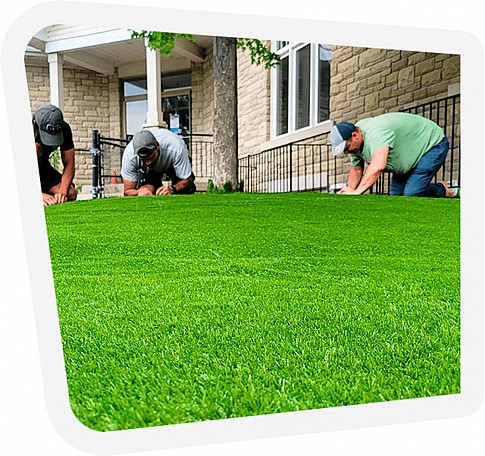Increasingly more homeowners are realizing the various advantages of choosing artificial turf over traditional grass. As people become progressively aware of the difficulties that come with maintaining a natural lawn, fake grass offers itself as a effective solution that not only addresses typical lawn issues but also provides a variety of benefits. From conserving visit this page on maintenance to providing a perfect green space throughout the year, artificial turf is gaining popularity for different reasons.
One of the highly compelling reasons to consider fake grass, especially for those suffering from allergies, is its ability to provide a hypoallergenic environment. Traditional grass can harbor pollen, dust mites, and other allergens, leading to discomfort for a lot of individuals. By opting for artificial turf, you can enjoy a gorgeous lawn without the constant sneezing and itching that real grass can bring. Additionally, homeowners appreciate the easy care appeal of synthetic turf, making it an ideal choice for busy families and those seeking to enhance their yards without the hassle of mowing, watering, or weeding. As we examine the top reasons why an increasing number of people are investing in artificial lawns, it becomes clear that fake grass might just be the best lawn decision you ever make.
Key Advantages of Fake Grass
One of the most notable benefits of artificial turf is its low-maintenance nature. Homeowners can say goodbye to the time-consuming activities of cutting, feeding, and irrigating. This simplicity not only reduces time but also allows for a more carefree lifestyle. By eliminating the need for regular care, artificial turf creates a stunning lawn with little effort, ensuring that you spend more time enjoying your yard rather than caring for it.
Another compelling argument to choose synthetic grass is its strength and toughness, making it the ideal solution for heavy-use areas. Fake grass can withstand heavy foot traffic without becoming bumpy. This makes it an excellent choice for homes with kids and animals, as it retains its aesthetic and quality regardless of how much use it receives. Plus, it holds up well in multiple climates, ensuring that your lawn looks wonderful throughout the year.
Fake grass also contributes to a more sustainable ecosystem by lessening the need for toxic chemicals and high water usage. With traditional lawns often requiring regular treatments of plant food and pesticides, moving to fake grass reduces exposure to these substances. This makes synthetic grass a more eco-friendly option, perfect for those wanting to create hypoallergenic landscaping while saving water and promoting a healthier environment.
Expense and Maintenance Savings
One of the most important advantages of choosing artificial turf is the cost savings, both in upfront cost and long-term care. While the initial cost of installation may be greater than that of natural grass, homeowners quickly discover that the savings on water bills, lawn care products, and maintenance services accumulate significantly over time. Unlike natural grass, synthetic turf negates the need for fertilizers, pesticides, and herbicides, saving you money and reducing environmental impact.
Maintenance is another area where artificial grass shines. With no need for mowing, trimming, or reseeding, busy homeowners can take back their weekends and use their free time for more enjoyable activities. The low-maintenance appeal of synthetic turf means you won't spend hours laboring in the yard, allowing you to invest your time more wisely. Additionally, most manufacturers provide warranties that ensure your turf will remain in top condition for years, further diminishing unforeseen costs.
In the future, artificial grass proves to be a intelligent financial decision. Its longevity means fewer repairs and replacements are needed, leading to significant savings. The ability to sustain a vibrant, green lawn without the outlay of water, equipment, and labor makes fake grass an attractive choice for homeowners looking to upgrade their outdoor spaces while maintaining costs manageable.
Environmentally-Friendly and Allergy Consideration
Opting for fake turf is more than a practical solution for homeowners and an sustainable decision that can lessen allergy concerns. Real grass often needs the use of chemical fertilizers and pesticides, which can contribute to air and water pollution. In https://jutedrop1.werite.net/artificial-turf-the-solution-to-a-flawless-lawn-year-round , synthetic grass dispenses with the need for these substances, providing a safe environment for families and pets alike. This aspect makes fake grass an appealing option for those who are mindful about their environmental footprint while ensuring a healthy outdoor space.

Moreover, many people suffer from pollen allergies triggered by grass and weeds, particularly in spring and the summer. Installing synthetic turf can significantly reduce exposure to these triggers, allowing allergy patients to experience their outdoor spaces free from the discomfort that accompanies seasonal allergies. By replacing real grass with synthetic alternatives, homeowners can create non-allergenic landscaping that enhances their well-being.
In addition to promoting a more sustainable environment, artificial grass contributes to water preservation efforts. Traditional lawns need regular irrigation, leading to high water use, especially in dry climates. With the elimination of watering, fake grass not only conserve water but also helps homeowners save on costs. As public consciousness of environmental issues grows, more people are realizing the benefits of artificial lawns, making it a wise investment for both personal and environmental health.
